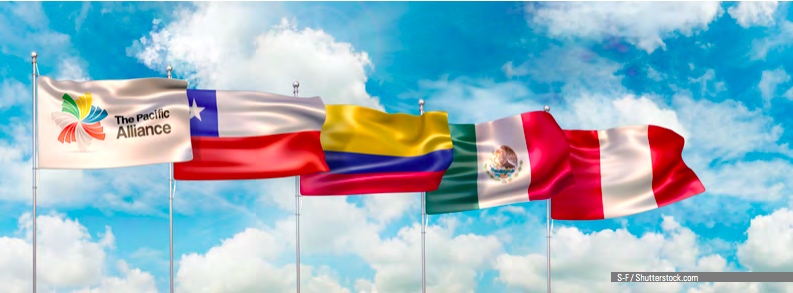Service chaining model between the Pacific Alliance and the Comprehensive and Progressive Agreement for Trans-Pacific Partnership
Main Article Content
Keywords
Pacific Alliance, Comprehensive and Progressive Agreement for TransPacific Partnership (CPTPP, TPP-11, TPP11), Trans-Pacific Partnership (TPP), Asia Pacific, investment, service chaining
Abstract
This article compares the chapter on investments in the Additional Protocol with the Pacific Alliance Framework Agreement (PA) and the chapter on investments in the Comprehensive and Progressive Agreement for Trans-Pacific Partnership (CPTPP). It also examines how both the chapters enable mode 3 of service trade (commercial presence) and service chaining to be used as an investment method in compliance with the chapters on cross-border service trade, which is included in both agreements to structure and design a Latin American service factory for the Asia-Pacific region. Owing to the coordination and level of agreement between both the regulatory systems, the purpose established in the Framework Agreement of the PA may be accomplished, the aim of this being to attract investments and promote service chaining (mode 3, commercial presence) with the AsiaPacific region.
Downloads
References
Alianza del Pacífico. (10 de febrero de 2014a). Declaración Presidencial de Cartagena de Indias. Recuperado el 27 de mayo de 2020, de Alianza del Pacífico: https://alianzapacifico.net/download/declaracion-decartagena-febrero-10-de-2014/
Alianza del Pacífico. (20 de junio de 2014b). Declaración de Punta Mita. Recuperado el 27 de mayo de 2020, de Alianza del Pacífico: https://alianzapacifico.net/download/declaracion-de-punta-mita-junio-20-de-2014/
Blyde, J., Volpe Martincus, C. y Molina, D. (octubre de 2014). Fábricas sincronizadas: América Latina y el Caribe en la era de las Cadenas Globales de Valor. Recuperado el 27 de mayo de 2020, de Banco Interamericano de Desarrollo: https://publications.iadb.org/es/publicacion/17526/fabricas-sincronizadasamerica-latina-y-el-caribe-en-la-era-de-las-cadenas
Del Valle Márquez, J. (2013). Perspectivas de la Alianza del Pacífico para la generación de encadenamientos productivos regionales. Recuperado el 27 de mayo de 2020, de Repositorio Académico de la Universidad de Chile: http://repositorio.uchile.cl/handle/2250/114601
Direcon. (s.f.). Cadenas globales de valor. Recuperado el 9 de febrero de 2018, de Direcon: https://www.direcon.gob.cl/minisitio/cadenas-globales-de-valor
López Aymes, J. (2014). Encadenamientos productivos en el sureste de Asia: integración a las redes globales con empresas locales. Online Journal Mundo Asia Pacifico, 3(5), 24-51. doi:https://doi.org/10.17230/map.v3.i5.02
Observatorio Estratégico de la Alianza del Pacífico. (Febrero de 2017). Estudio sobre comercio de servicios en la Alianza del Pacífico. Normas vigentes para prestar servicios de ingeniería y de tecnología de información en los países miembros. Recuperado el 27 de mayo de 2020, de Confederación de la Producción y del Comercio: http://www.cpc.cl/wp-content/uploads/2017/03/ESTUDIO-SOBRE-COMERCIO-DE-SERVICIOSAP-2017.pdf
Organización de Estados Americanos. (s.f.). Acuerdo Amplio y Progresista de Asociación Transpacífico (CPTPP). Recuperado el 17 de junio de 2020, de Sistema de Información sobre Comercio Exterior: http://www.sice.oas.org/TPD/TPP/TPP_s.ASP
Organización Mundial del Comercio. (A). El Acuerdo General sobre el Comercio de Servicios (AGCS): objetivos, alcance y disciplinas. Recuperado el 27 de mayo de 2020, de Organización Mundial del Comercio:https://www.wto.org/spanish/tratop_s/serv_s/gatsqa_s.htm
Organización Mundial del Comercio. (B). Información por sectores de servicios. Recuperado el 27 de mayo de 2020, de Organización Mundial del Comercio: https://www.wto.org/spanish/tratop_s/serv_s/serv_sectors_s.htm
Porter, M. (1998). Clusters and the New Economics of Competition. Harvard Business Review, 76(6), 77-90.
Tuck, A. (2014). The Road to Integration: the Pacific Alliance, the TPP, and Latin America. National Center For APEC.

